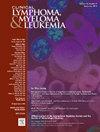Matching-Adjusted Indirect Comparison of Daratumumab-Pomalidomide-Dexamethasone and Pomalidomide-Bortezomib-Dexamethasone in Relapsed/Refractory Multiple Myeloma
IF 2.7
4区 医学
Q2 HEMATOLOGY
引用次数: 0
Abstract
Background
Standard-of-care treatment for patients with multiple myeloma (MM) typically includes frontline lenalidomide until disease progression, making lenalidomide-refractoriness a challenge in relapsed/refractory MM (RRMM). Lenalidomide-sparing triplet therapies, daratumumab, pomalidomide, and dexamethasone (DPd) and pomalidomide, bortezomib, and dexamethasone (PVd), demonstrated efficacy in lenalidomide-exposed patients in the APOLLO and OPTIMISMM trials, respectively. Without head-to-head trial data, we assessed the comparative effectiveness of DPd versus PVd via matching-adjusted indirect comparison (MAIC).
Materials and Methods
Using APOLLO individual patient data (IPD) and OPTIMISMM aggregate covariate data plus pseudo-IPD for outcomes, the APOLLO population was re-weighted to match OPTIMISMM aggregate baseline characteristics. Bayesian posterior distributions of DPd versus PVd for progression-free survival (PFS) and overall survival (OS) were estimated using a likelihood-weighted Bayesian Cox model with fixed weights.
Results
At baseline, APOLLO included a higher proportion of patients who received ≥ 2 prior lines of therapy, were refractory to prior therapies, and had advanced International Staging System stage versus OPTIMISMM, which would otherwise disadvantage APOLLO versus OPTIMISMM. The PFS hazard ratio (HR) favored DPd over PVd at 0.59 (95% credible interval [CrI]: 0.36, 0.89) with 99% probability of DPd superiority versus PVd. The OS HR appeared to favor DPd over PVd at 0.80 (95% CrI: 0.45, 1.30), with 83% probability of DPd superiority versus PVd; however, the estimated OS benefit was not conclusive.
Conclusion
This analysis suggests that DPd improves PFS and might improve OS versus PVd in patients with RRMM. Additional evidence from head-to-head trials or real-world patient databases are warranted to confirm these results.
达拉图单抗-波马度胺-地塞米松与波马度胺-硼替佐米-地塞米松治疗复发/难治性多发性骨髓瘤的经匹配调整的间接比较
背景:多发性骨髓瘤(MM)患者的标准治疗通常包括一线来那度胺直到疾病进展,这使得来那度胺的难治性成为复发/难治性MM (RRMM)的挑战。在APOLLO和OPTIMISMM试验中,来那度胺保留三联疗法,达拉单抗、泊马度胺和地塞米松(DPd)以及泊马度胺、硼替佐米和地塞米松(PVd)分别证明了来那度胺暴露患者的疗效。在没有正面试验数据的情况下,我们通过匹配调整间接比较(MAIC)评估了DPd与PVd的比较有效性。材料和方法:使用APOLLO个体患者数据(IPD)和OPTIMISMM汇总协变量数据加上结果的伪IPD, APOLLO人群被重新加权以匹配OPTIMISMM汇总基线特征。使用固定权重的似然加权贝叶斯Cox模型估计DPd与PVd的无进展生存期(PFS)和总生存期(OS)的贝叶斯后验分布。结果:在基线时,APOLLO纳入了更高比例的患者,这些患者接受过≥2条既往治疗线,对既往治疗难治性,与OPTIMISMM相比,其国际分期系统分期较先进,否则将不利于APOLLO与OPTIMISMM。PFS风险比(HR)为0.59(95%可信区间[CrI]: 0.36, 0.89), DPd优于PVd的概率为99%。OS HR显示DPd优于PVd为0.80 (95% CrI: 0.45, 1.30), DPd优于PVd的概率为83%;然而,估计的OS收益并不是决定性的。结论:该分析表明,DPd可改善RRMM患者的PFS,并可能改善OS与PVd。来自面对面试验或真实患者数据库的额外证据有必要证实这些结果。
本文章由计算机程序翻译,如有差异,请以英文原文为准。
求助全文
约1分钟内获得全文
求助全文
来源期刊

Clinical Lymphoma, Myeloma & Leukemia
ONCOLOGY-HEMATOLOGY
CiteScore
2.70
自引率
3.70%
发文量
1606
审稿时长
26 days
期刊介绍:
Clinical Lymphoma, Myeloma & Leukemia is a peer-reviewed monthly journal that publishes original articles describing various aspects of clinical and translational research of lymphoma, myeloma and leukemia. Clinical Lymphoma, Myeloma & Leukemia is devoted to articles on detection, diagnosis, prevention, and treatment of lymphoma, myeloma, leukemia and related disorders including macroglobulinemia, amyloidosis, and plasma-cell dyscrasias. The main emphasis is on recent scientific developments in all areas related to lymphoma, myeloma and leukemia. Specific areas of interest include clinical research and mechanistic approaches; drug sensitivity and resistance; gene and antisense therapy; pathology, markers, and prognostic indicators; chemoprevention strategies; multimodality therapy; and integration of various approaches.
 求助内容:
求助内容: 应助结果提醒方式:
应助结果提醒方式:


